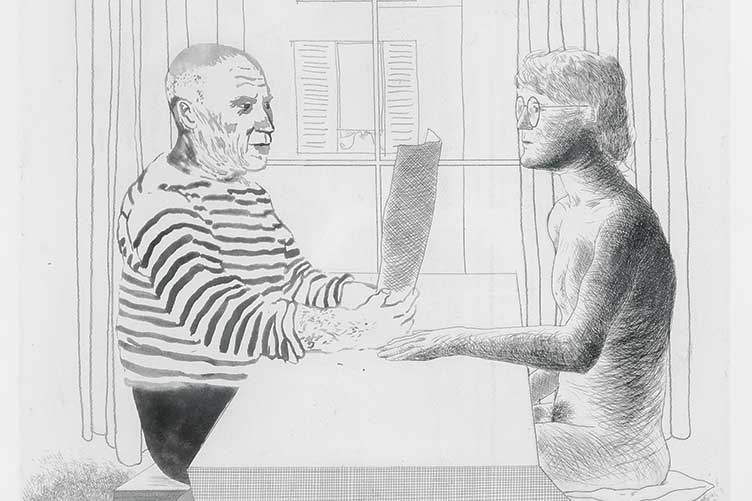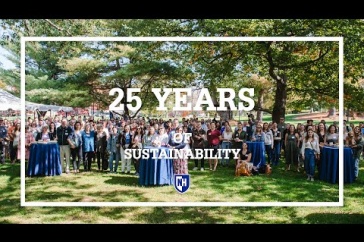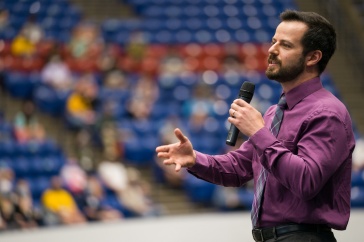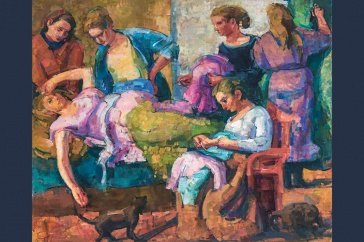
Artist and Model, David Hockney, 1974
When the exhibit "Graphicornucopia" opens at the UNH Museum of Art in September, the university community will get a look at new artwork that enhances the museum's greater collection and provides major research opportunities for students and staff, thanks to the generous donation of two alums.

collection includes works by
a broad range of mid-20th
century artistic luminaries.
From top: Untitled, Sam
Francis, 1968; Park Place
Variations, Wayne Thibaud,
1995; Target with Four Faces,
Jasper Johns, 1979; Untitled,
Eduardo Chillida, 1970.
Sixty-two prints, a portion of which will be exhibited in the fall, have been donated by Dr. Lawrence Staples '49,'50G and Marilyn Staples '48 of Des Moines, Iowa. It's a wide-ranging collection of modern prints by mid-20th century American and European artists that Kristina Durocher, director of the museum, describes as a significant gift. "It fills in a huge gap for us," Durocher says. "Many of these artists were not represented in our collection, and some of the artists are very well known."
The collection, which includes work by such artistic luminaries as Jasper Johns, Frank Stella, Jim Dine, David Hockney, and Robert Motherwell, represents a period of great change and innovation in art, and is a vivid glimpse into life in the decades between the 1960s and 1990s. Visitors to the exhibit will see still life, landscapes, figurative work, collages, and geometric abstractions. A colorful Richard Estes print of airplanes parked at an airport is a linear nod to the golden age of flight, and is juxtaposed with the more fluidly abstract bursts of color in Sam Francis's work. Still another, a William Bailey still life of softly colored ceramic crockery, is a study of calm. "There is just so much variety to view, and so many opportunities for learning about art, culture, and history," Durocher says.
Some of the works are representative of artists working from photographs or experimenting with the newer technology of the time, or are rare examples of artists using the print medium as a part of their own creative process. For example, one large piece depicts a grizzled human head on a pedestal. Artist Robert Arneson, considered the father of the 1960s ceramic Funk movement, was primarily a sculptor but created the print to help guide his work. "To have his work as a print is amazing," said Durocher.
Durocher said the breadth of the Staples collection is so varied and valuable that UNH students will have myriad opportunities to study and learn. "The Staples collection has renewed interest and enthusiasm for print study. Students will work with the collection to catalog and frame, and to study the historical, political, and biographical contexts," says Durocher, who expects students from a variety of disciplines will benefit. "It enhances the museum as a resource for the entire university."
For their part, Larry and Marilyn Staples were confident that UNH would provide a good home for a collection that they accumulated over seven decades and a pair of successful careers in medicine and education, respectively. "We are very fond of UNH," Marilyn Staples says. "It gave us the foundation for the following years. We hope the art will be enjoyed by others and be a resource for the art department."
"Graphicornucopia" will run from September 4 to October 19. The exhibit will include many of the Staples' prints and also some complementary pieces from the museum's permanent collection of 1,700 works of art, which includes paintings, drawings, prints, photography, ceramics, and sculpture.
Originally published by:
UNH Magazine, Spring 2014 Issue
-
Written By:
Katie Fiermonti | Communications and Public Affairs



















































